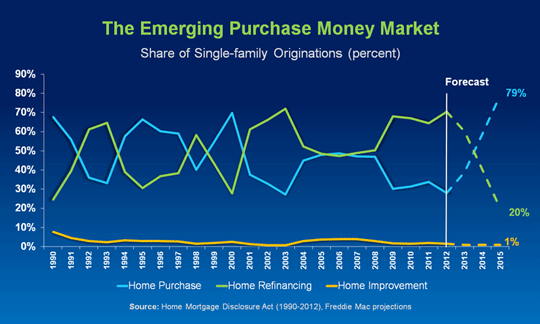The coming year should bring an emergence of the first purchase-dominated market the U.S. has seen since 2000 Freddie Mac predicted today. The single-family mortgage market will soon begin a transition from a rate-and-term refinance dominated market, the company's Chief and Deputy Chief Economists said, to one in which home purchase loans will take the lead.
Freddie Mac's November U.S. Economic and Housing Market Outlook might be the sunniest forecast Frank Nothaft and Leonard Kiefer have published in some months. They see economic growth in the 2.5 to 3.0 percent range, more than half a percentage point above 2013 expectations and a quickening recovery that will lead to more job creation and an unemployment rate below 7 percent, perhaps by mid-year. And housing features prominently in the medium range outlook.
Freddie Mac expects single-family home sales and housing starts to be at the highest level since 2007 and multifamily transactions and construction to post gains as well. Housing will remain affordable in most parts of the country despite rising interest rates and household formations should finally pick up. The later, along with a slow growth in housing completions should keep inventories tight and vacancies low.
The details:
- Home sales should rise about 5 percent. Add in home price gains, a decline in all cash purchases, and purchase-money lending may be up about 15 percent in 2014 compared to 2013. At the same time, the upward creep in mortgage rates and a dwindling pool of refinance candidates will convert the market to one dominated by purchase money in 2014 and even more so in 2015.

- Interest rates are already off of record lows and will continue to move up in 2014, probably ending the year at close to 5 percent. There will be volatility wherever there are concerns about fiscal policy and when the Federal Reserve finally announces the "taper" markets will probably jump around as well.
- Housing affordability should hold up well even with rising rates. Large cities along both coasts are already expensive for the typical family so rising rates will have a greater effect there. "But in most parts of the country, incomes and home prices are such that rising rates by themselves will not be enough to end the recovery. What we need is some better income growth," Nothaft and Kiefer say.
- Housing construction, while improved, is still at a low level, not yet sufficient to keep up with household formations, second home demand, and the decommissioning of existing homes. Starts have risen to about a 900,000 annualized rate and should increase to about 1.15 million next year. This, using the National Association of Home Builders figure of three jobs created for every home built, should result in close to 700,000 jobs, and a lower unemployment rate.
- Many potential sellers are constrained by negative equity and Freddie Mac expects demand to match or exceed supply. Higher home prices and increased construction will improve inventories in some markets but the economists predict home sales will be able to rise only about 5 percent in 2014 compared to 2013. Tight inventories and relative affordability should help support continued price increases.
- Rental property values have risen well over the past year but more modestly than home prices - about 5.3 percent. Freddie Mac's Multifamily Investment Index remains well above its 2000-2013 average suggesting that sector remains a relatively attractive investment compared with the last decade.







